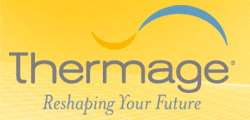Thermage tackes it's safety reputation among physicians.
This post was written for Medical Spa MD by Thermage.
Thermage Safety - The whole story
Clint Carnell, Thermage, VP Domestic Sales
 In reply to your recent blog entitled “Thermage: Do plastic surgeons hate everything non-surgical?” I am Vice President of Domestic Sales for Thermage:
In reply to your recent blog entitled “Thermage: Do plastic surgeons hate everything non-surgical?” I am Vice President of Domestic Sales for Thermage:
Much is written about the risks of Thermage, in particular the risk of fat atrophy and surface irregularities referred to in your blog. Though there were some initial infrequent reports of such effects associated with Thermage after its product was released in 2002, the simple fact is that today Thermage is an extremely safe procedure, and has been so for several years.
Thermage invented the concept of using non-invasive radio frequency energy for tissue tightening and contouring. Thermage launched its first product in late 2002. Though the overwhelming majority of initial treatments were problem free, fat atrophy and surface irregularities were reported in 0.23% of the procedures (2.3 per 1000 patients) in 2002-2003.
Thermage’s investigation revealed that 100% of the early reports were from 6% of its physician practitioners.
Our investigation also revealed the cause was over treatment – using excessively high energy settings. If relatively high treatment settings are used, it is possible to overheat deeper tissue, especially in thin-skinned individuals. The use of nerve blocks, tumescent anesthesia, and/or intravenous sedation that completely blocked patient pain perception and feedback was also found to be a contributing factor.
In response to these findings, in January-February 2004, Thermage launched an aggressive physician education program instructing physicians to adopt treatment techniques to avoid tissue overheating. The techniques included:
- Use of a treatment grid to avoid pulse stacking.
- Use of multiple passes at moderate power settings rather than single passes at higher energy settings.
- Allow 2 minutes between passes to allow temperature reequilibration.
- Use patient feedback of heat sensation, and treat to a heat sensation level of 2-2.5 on a scale of 0-4 (4 being maximum sensation).
- Use minimal pain blocking.
- Pay special attention to patient feedback while treating thin-skinned areas.
As reported by Narins (1), these new treatment techniques proved to be immensely successful. During the 6 months following their introduction, the reported incidence of fat atrophy and surface irregularities decreased by a factor of roughly 6 (to 0.04%), and there were no reported incidents in the last half of 2004. This improving trend has continued to the present. For example, the reported incidence of fat atrophy and surface irregularities for all of 2006 was 0.016% (less than 2 cases in 10,000). A similar dramatic decline in all other reported adverse events (e.g., burns, welts, swelling/edema, etc.) has also been observed. Today, Thermage is an extremely safe procedure.
In addition to significantly increasing patient safety, the new treatment guidelines have also significantly reduced the discomfort of treatment, since physicians now treat to a very tolerable heat sensation level of 2-2.5.
Finally, the new treatment guidelines, in particular the use of multiple passes at moderate settings, have also significantly increased efficacy from that reported initially in 2002-2003. Several peer-reviewed studies show Thermage patient satisfaction to be higher than 80%, and continuing to improve over time.2,3,4 Thermage results are most notably perceptible when it comes to an eyebrow lift or softening of the nasolabial fold, and provide a remarkably natural look. However, we do acknowledge Thermage results can sometimes be subtle and are not nearly as dramatic as those produced by surgery.
References
1 Narins, RS, et. al. Overtreatment Effects Associated with a Radiofrequency Tissue Tightening Device: Rare, Preventable, and Correctable with Subcision and Autologous Fat Transfer. Dermatology Surgery 2006;32:115-124; January 2006.
2 Weiss, R.A. et. al. Monopolar Radiofrequency Facial Tightening: A Retrospective Analysis of Efficacy and Safety in Over 600 Treatments. Journal of Drugs in Dermatology – Vol. 5; Issue 8; 707-712; September 2006.
3 Finzi, E. et. al. Multipass Vector (Mpave) Technique with Nonablative Radiofrequency to Treat Facial and Neck Laxity. Dermatol Surg 31 (8 Pt 1); 916-22; August 2005.
4 Biesman, B. et. al. Monopolar Radiofrequency Treatment of Human Eyelids: A Prospective, Multicenter, Efficacy Trial. Lasers in Surgery and Medicine 38:890-898; December 2006.